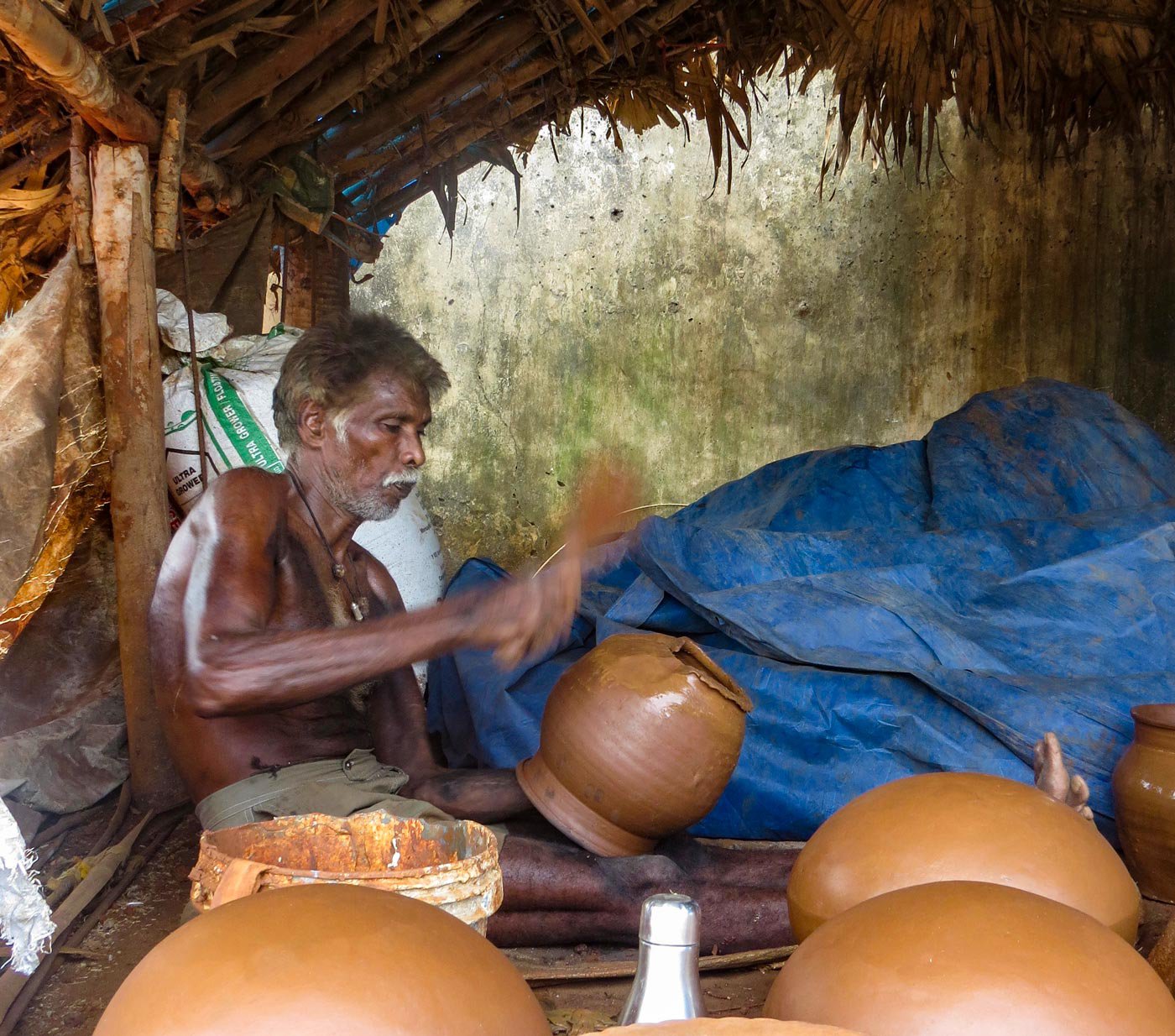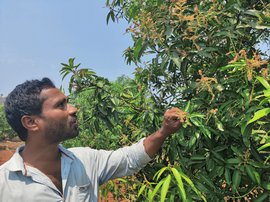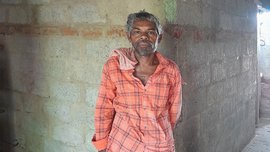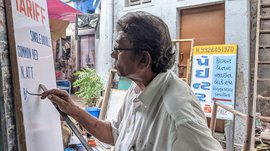Tak-tak-tak!
The rhythmic sounds are coming from a tarpaulin-covered hut in Kodavatipudi. Mulampaka Bhadraraju is tapping a pot using a chekka sutti , a small paddle-like wooden hammer that moulds a pot into a perfect round shape.
“The thicker chekka sutti is for closing the bottom of the pot. This regular one is for making the bottom more smooth. The thinnest chekka sutti is for smoothening the entire pot,” explains the 70–year-old Bhadraraju who switches between hammers depending upon what is needed.
He says the thinner, regular-sized one is made from the branches of the palm tree ( Borassus flabellifer ) and the thickest one from the arjuna tree ( Terminalia arjuna ). He moves to the thinnest chekka sutti and the beat gets significantly quieter.
It takes him about 15 minutes to shape a large pot measuring 20 inches in diameter. If he breaks or ruptures a side, he quickly fixes it by adding clay and repeating the tapping process.


Mulampaka Bhadraraju uses a chekka sutti (left) to smoothen the pot. The bowl of ash (right) helps ensure his hand doesn't stick to the wet pot
Bhadraraju has been a potter since he was
15 years old. He lives and works in Kodavatipudi, a village in Anakapalli
district, and belongs to the
Kummara
community, listed as Other Backward Caste (OBC) in Andhra Pradesh.
The septuagenarian potter gets his clay from a pond on land he bought 15 years ago – a half an acre for Rs. 1,50,000. Through the year, he also pays Rs. 1,000 to get 400 kilograms of erra mitti (red clay) delivered to his plot from a sand, soil and gravel supplier in Kotauratla, the neighbouring village.
He built two huts on the land using the leaves of the coconut palm and tarpaulin as roofing. The covered space allows him to work year-round without the monsoon disrupting his work. He uses one hut to make and shape the pots; in the smaller hut he bakes them. “When we have 200-300 pots, we bake them [over a bed of dry wood],” he says, collected from an open ground nearby. “They [pots] dry in the hut itself,” he adds.
He paid for this land with his savings. “They [local banks] did not give me a loan. I have asked them many times before, but no one ever gave me a loan.” He prefers not to deal with moneylenders as his work output is uncertain – for every 10 pots he makes, 1-2 break in the process. “Not all the pots dry perfectly, a portion of the pots breaks apart while drying,” he says, pointing to the dozen cracked pots lying in the corner of the hut.


The master potter can finish shaping about 20-30 pots a day
The process of making pots, from start to finish, usually takes him about a month; he works nearly 10 hours a day. “If my wife helps, we can finish [shaping] even 20-30 pots a day,” he says as he continues tapping, pausing only now and then to emphasise a point as he is speaking. At the end of the month, the tally is roughly 200-300 pots.
This is the sole source of income for his family of six — his three daughters, one son, and his wife. “Only this,” he asserts, has paid for household expenses and his children’s marriages.
Bhadraraju sells his pots to wholesalers from Visakhapatnam and Rajahmundry who come every week and pick them up from the roughly 30 kummaras in the village. The pots are sold in the market for various purposes: “For cooking, for calves to drink from, whatever serves their needs,” says the potter.
“Wholesalers from Visakhapatnam buy it for 100 rupees per pot, whereas in Rajahmundry wholesalers buy it for 120 rupees per unit,” says Bhadraraju and adds, “If everything goes well, I can get 30,000 rupees [in a month].”
Ten years ago, Bhadraraju worked as a potter in an arts and crafts shop in Goa. “People of several other states were also there, all engaged in different crafts,” he says. He would get Rs. 200-250 for each pot. “But the food there was unsuitable for me so I left after six months,” he says.
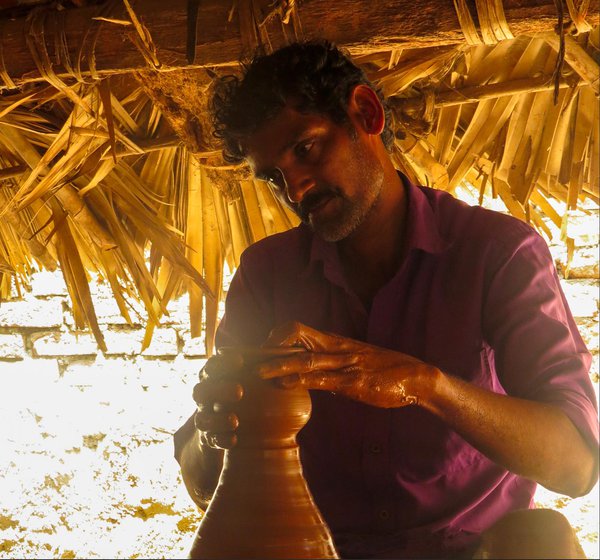
Manepalli switched to a electric wheel five years ago
'I have had an ulcer in my stomach for the past 6-7 years,' says Manepalli. The manual wheel caused him pain when he spun it, and the automatic machine wheel is pain-free. Also from the Kummara community, the 46-year-old has been doing this work since he was a teenager
A few metres away is the home of Kameshwararao
Manepalli, also a potter. Here
the thudding sound of the
chekka sutti
has
been replaced by a slow, whirring sound from a machine-run wheel which will
shape the pot on the wheel itself.
All the potters in the village have switched to machine-run wheels. Bhadraraju is the only one who still manually operates a wheel and isn’t interested in switching to a machine-operated wheel. “I have been doing this work since I was 15,” he says, adding that he is used to long working hours and labour. The machine-run wheels are also designed to make much smaller pots, and not the traditional 10-litres ones that Bhadraraju makes.
Manepalli, like many older potters, switched to a machine-run wheel five years ago due to ill health and surgery, “I have had an ulcer in my stomach for the past 6-7 years,” he says. The manual wheel caused him pain when he spun it. The automatic machine wheel was pain free.
“I bought a machine-operated potter’s wheel for 12,000 rupees. After it got damaged, I received another one from the Khadi Grahmina Society for free. I make pots with that now.”


Left: Manepalli’s batch of pots being baked. Right: He holds up a clay bottle he recently finished baking
“The plain [small] pot costs 5 [rupees].
If you put a design on it, it would cost 20,” he says, emphasising that they
are used for decoration only. Also from the Kummara community, the 46-year-old
has been doing this work since a teenager along with his father. He has
continued to work alone after his father passed away 15 years ago.
Manepalli is the sole earner for his family of six – three children, wife and mother. “If I work every day, I earn 10,000 [rupees a month]. The charcoal for burning the pots costs around 2,000 rupees. After that, I am only left with 8,000 rupees.”
The veteran potter works irregular hours because of his poor health, often skipping work days entirely. “What else can I do?” he says when asked if he does any other work, adding, “this is the only job I have.”
